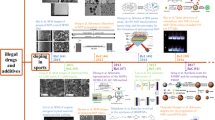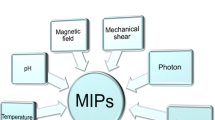Abstract
Molecularly imprinted polymers (MIP) for histamine using methacrylic acid were developed and recognition mechanisms were thoroughly characterized for the first time in this study. The binding affinity of imprinted polymer with structurally related compounds was studied in organic and aqueous media, at various conditions. In organic media, MIP was found to bind histamine two and six times more than ranitidine and fluoxetine, respectively, whereas higher selectivity was observed in the case of dimentidene or disodium cromoglycate. The specific binding sites of MIP recognized histamine over l-histidine in aqueous conditions, while higher affinity for histamine compared to ranitidine, disodium cromoglycate, putrescine and to a putrescine analogue was observed. A combination of NMR and UV spectroscopy analyses for investigation of imprinting and recognition properties revealed that strong specific interactions between the functional monomer and histamine in the prepolymerization and in the aqueous solutions were probably responsible for histamine recognition. The preparation of histamine MIPs and elucidation of imprinting and recognition mechanism may serve as useful insight for future application of MIPs.











Similar content being viewed by others
Abbreviations
- L-His:
-
l-Histidine
- MIP:
-
Molecularly imprinted polymer
- REF:
-
Reference polymer
- PUT:
-
Putrescine
- HI:
-
Histamine
- SPMD:
-
Spermidine
- SPM:
-
Spermine
- MAA:
-
Methacrylic acid
- EDMA:
-
Ethylene glycol dimethacrylate
- TRIM:
-
Trimethylolpropane trimethacrylate
- SPE:
-
Solid phase extraction
- MISPE:
-
Molecularly imprinted solid phase extraction
References
Allender CJ, Richardson B, Woodhouse CM, Heard CM, Brain KR (2000) Pharmaceutical applications for molecularly imprinted polymers. Int J Pharm 195:39–43
Andersson LI (1996) Application of molecular imprinting to the development of aqueous buffer and organic solvent based radioligand binding assays for (S)-propranolol. Anal Chem 68:111–117
Andersson LI (2000) Molecular imprinting for drug bioanalysis: a review on the application of imprinted polymers to solid-phase extraction and binding assay. J Chromatogr B 739:163–173
Andersson LI, Abdel-Rehim M, Nicklasson L, Schweitz L, Nilsson S (2002) Towards molecular-imprint based SPE of local anesthetics. Chromatographia 55:65–69
Bongaers E, Alenus J, Horemans F, Weustenraed A, Lutsen L, Vanderzande D, Cleij TJ, Troost FJ, Brummer RJ, Wagner P (2010) A MIP-based biomimetic sensor for the impedimetric detection of histamine in different pH environments. Phys Status Solidi A 207(4):837–843
Broeders J, Duchateau S, Van Grinsven B, Vanaken W, Peeters M, Cleij TJ, Thoelen R, Wagner P, De Ceuninck W (2011) Miniaturised eight-channel impedance spectroscopy unit as sensor platform for biosensor applications. Phys Status Solidi A 208(6):1357–1363
Cai W, Gupta R (2004) Molecularly-imprinted polymers selective for tetracycline binding. Sep Purif Technol 35:215–221
Dmitrienko SG, Irkha VV, Mikhailik YV, Klokova EV (2006) Influence of the functional monomer/template ratio in the prepolymerization mixture on the sorption properties of molecularly imprinted polymers of organic compounds. Mosc Univ Chem Bull 61:54–61
Fukui H (2008) Progress in allergy signal research on mast cells: up-regulation of histamine signal-related gene expression in allergy model rats. J Pharmacol Sci 106:325–331
Greene NT, Shimizu KD (2005) Colorimetric molecularly imprinted polymer sensor array using dye displacement. J Am Chem Soc 127:5695–5700
Hart BR, Shea KJ (2001) Synthetic peptide receptors: molecularly imprinted polymers for the recognition of peptides using peptide-metal interaction. J Am Chem Soc 23:2072–2073
Haupt K, Mosbach K (2000) Molecularly imprinted polymers and their use in biomimetic sensors. Chem Rev 100:2495–2504
Hilt JZ, Byrne ME (2004) Configurational biomimesis in drug delivery: molecular imprinting of biologically significant molecules. Adv Drug Deliv Rev 56:1599–1620
Horemans F, Alenus J, Bongaers A et al. (2010) MIP-based sensor platform for the detection of histamine in the nano-and micromolar range in aqueous media. Sens Actuators B 392–398
Karim K, Breton F, Rouillon R, Piletska EV, Guerreiro A, Chianella I, Piletsky S (2005) How to find effective functional monomers for effective molecularly imprinted polymers? Adv Drug Deliv Rev 57:1795–1808
Karlsson JG, Andersson LI, Nicholls IA (2001) Probing the molecular basis for ligand-selective recognition in molecularly imprinted polymers selective for the local anaesthetic bupivacaine. Anal Chim Acta 435:57–64
Kempe M, Mosbach KJ (1995) Separation of amino acids, peptides and proteins on molecularly imprinted stationary phases. J Chromatogr A 691:317–323
Moral NP, Mayes AG (2006) Direct rapid synthesis of MIP beads in SPE cartridges. Biosens Bioelectron 21:1798–1803
Mosbach K, Ramström O (1996) The emerging technique of molecular imprinting and its future impact on biotechnology. Bio/Technol 14:163–170
Ohtsu H (2008) Progress in allergy signal research on mast cells: the role of histamine in immunological and cardiovascular disease and the transporting system of histamine in the cell. J Pharmacol Sci 106:347–353
Papaioannou EH, Liakopoulou-Kyriakides M, Papi RM, Kyriakidis DA (2007) Molecularly imprinted polymers for cholecystokinin C-terminal pentapeptide recognition. Macromol Chem Phys 208:2621–2627
Pietrzyk A, Suriyanarayannan S, Kutner W, Chitta R, D’Souza F (2009) Selective histamine piezoelectric chemosensor using a recognition film of the molecularly imprinted polymer of bis(bithiophene) derivatives. Anal Chem 81:2633–2643
Pretsch E, Bühlmann P, Affolter C (2000) Structure determination of organic compounds, 3rd edn. Springer, Berlin, p 207
Rachkov A, Hu M, Bulgarevich E, Matsumoto T, Minoura N (2004) Molecularly imprinted polymers prepared in aqueous solution selective for [Sar1, Ala8] angiotensin II. Anal Chim Acta 504:191–197
Raczyńska ED, Darowska M, Cyrański MK, Makowski M, Rudka T, Gal JF, Maria PC (2003) Ab initio study of tautomerism and of basicity centre preference in histamine, from gas phase to solution-comparison with experimental data (gas phase, solution, solid state). J Phys Org Chem 16:783–796
Ramström O, Ye L, Gustavsson PE (1998) Chiral recognition by molecularly imprinted polymers in aqueous media. Chromatographia 48:197–202
Rosen H (1957) A modified ninhydrin colorimetric analysis for amino acids. Arch Biochem Biophys 67:10–15
Santos MHS (1996) Biogenic amines: their importance in foods. Int J Food Microbiol 29:213–231
Sellergren B (1994) Direct drug determination by selective sample enrichment of an imprinted polymer. Anal Chem 66:1578–1582
Sellergren B, Shea KJ (1993a) Chiral ion exchange chromatography. Correlation between solute retention and a theoretical ion exchange model using imprinted polymers. J Chromatogr A 654:17–28
Sellergren B, Shea KJ (1993b) Influence of polymer morphology on the ability of imprinted network polymers to resolve enantiomers. J Chromatogr A 635:31–49
Shi X, Wu A, Qu G, Li R, Zhang D (2007) Development and characterisation of molecularly imprinted polymers based on methacrylic acid for selective recognition of drugs. Biomaterials 28:3741–3749
Silvestry D, Borrelli C, Giusti P, Cristallini C, Ciardelli G (2005) Polymeric devices containing imprinted nanospheres: a novel approach to improve recognition in water for clinical uses. Anal Chim Acta 542:3–13
Tong A, Dong H, Li L (2002) Molecular imprinting-based fluorescent chemosensor for histamine using zinc(II)-protoporphyrin as a functional monomer. Anal Chim Acta 466:31–37
Vlatakis G, Andersson LI, Müller R, Mosbach K (1993) Drug assay using antibody mimics made by molecular imprinting. Nature 361:645–647
Wang M, Wu D, Yao Q, Shen X (2004) Separation and selectivity in micellar electrokinetic chromatography using sodium dodecyl sulfate micelles or Tween 20-modified mixed micelles. Anal Chim Acta 519:73–78
Watabe Y, Hosoya K, Tanaka N, Kubo T, Kondo T, Morita M (2005) Novel surface modified molecularly imprinted polymer focused on the removal of interference of environmental water samples for chromatographic determination. J Chromatogr A 1073:363–370
Wei S, Molinelli A, Mizaikoff B (2006) Molecularly imprinted micro and nanospheres for the selective recognition of 17β-estradiol. Biosens Bioelectron 21:1943–1951
Winters AL, Lloyd JD, Jones R, Merry RJ (2002) Evaluation of a rapid method for estimating free amino acids in silages. Anim Feed Sci Technol 99:177–187
Xu YL, Liu ZS, Wang HF, Yan C, Gao RY (2005) Chiral recognition ability of an (S)-naproxen- imprinted monolith by capillary electrochromatography. Electrophoresis 26:804–811
Xu ZF, Liu L, Deng QY (2006) Study on the mechanism of binding specificity of metoclopramide-imprinted polymers. J Pharm Biomed 41:701–706
Xu Z, Kuang D, Liu L, Deng QJ (2007) Selective adsorption of norfloxacin in aqueous media by an imprinted polymer based on hydrophobic and electrostatic interactions. Pharm Biomed Anal 45:54–61
Yan M, Ramström O (2005a) Molecularly imprinted materials. Science and technology. Marcel Dekker, New York, p 412
Yan M, Ramström O (2005b) Molecularly imprinted materials. Science and technology. Marcel Dekker, New York, pp 29–32
Ye L, Haupt K (2004) Molecularly imprinted polymers as antibody and receptor mimics for assays, sensors, and drug discovery. Anal Bioanal Chem 378:1887–1897
Yoshimatsu K, Reimhult K, Krozer A, Mosbach K, Sode K, Ye L (2007) Uniform molecularly imprinted microspheres and nanoparticles prepared by precipitation polymerization: the control of particle size suitable for different analytical applications. Anal Chim Acta 584:112–121
Yu C, Mosbach K (1998) Insights into the origins of binding and the recognition properties of molecularly imprinted polymers prepared using an amide as the hydrogen-bonding functional group. J Mol Recognit 11:69–74
Yu C, Ramström O, Mosbach K (1997) Enantiomeric recognition by molecularly imprinted polymers using hydrophobic interactions. Anal Lett 30:2123–2140
Zhu QZ, Haupt K, Knopp D, Niessner R (2002) Molecularly imprinted polymer for metsulfuron-methyl and its binding characteristics for sulfonylurea herbicides. Anal Chim Acta 468:217–227
Acknowledgments
This work was supported by the European Union program: Nanoimprinting Technologies for Selective Recognition and Separation, Contract no.: NMP4-CT-2005-516981. This work was part of the EU COST Action BM0806: recent advances in histamine receptor H4R research. F. A. Trikka was a recipient of the Erasmus fellowships. The authors like to thank Professor D. Papaioannou, University of Patras, Greece, for providing the cyclic analogue of putrescine.
Author information
Authors and Affiliations
Corresponding author
Electronic supplementary material
Below is the link to the electronic supplementary material.
Rights and permissions
About this article
Cite this article
Trikka, F.A., Yoshimatsu, K., Ye, L. et al. Molecularly imprinted polymers for histamine recognition in aqueous environment. Amino Acids 43, 2113–2124 (2012). https://doi.org/10.1007/s00726-012-1297-8
Received:
Accepted:
Published:
Issue Date:
DOI: https://doi.org/10.1007/s00726-012-1297-8




